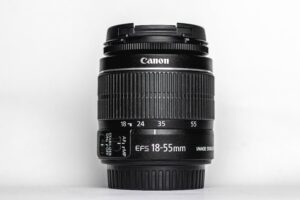When it comes to zoom lenses vs. prime lenses, both have their unique merits and drawbacks.
Zoom lenses offer unparalleled flexibility, while prime lenses are the go-to for superior image quality.
Intrigued? Stick around to read more into the nitty-gritty of each type, explore their pros and cons, and get tips from professional photographers to make an informed decision.
Table: Quick Comparison
| Aspect | Prime Lenses | Zoom Lenses |
|---|---|---|
| Flexibility | Limited | High |
| Image Quality | Excellent | Good to Very Good |
| Price | Generally Lower | Varies, can be expensive |
| Practicality | Specific Uses | Multiple Purposes |
| Weight | Lighter | Heavier |
What is a Prime Lens?
Definition and Basic Characteristics
A prime lens is a camera lens with a fixed focal length. This means you can’t zoom in or out; what you see is what you get.
These lenses are often simpler in design and offer a wide aperture, allowing for more light to enter, which is excellent for low-light conditions.
How Prime Lenses Work
Prime lenses have a fixed focal length, meaning they have a set field of view. They consist of fewer glass elements, which often results in superior optical quality.
The aperture in prime lenses is usually wider, allowing for more light to enter the camera sensor. This makes them excellent for low-light conditions and achieving a shallow depth of field.
The simplicity in design often leads to sharper images with more detail.
How to Shoot With a Prime Lens
Shooting with a prime lens requires a bit of a different approach.
Since you can’t zoom, you’ll need to “zoom with your feet,” meaning you’ll have to move closer or farther away from your subject to frame your shot.
This limitation can actually spark creativity, forcing you to think more about composition and angles.
- Step 1: Understand Your Focal Length – Different prime lenses come with different focal lengths, like 35mm, 50mm, or 85mm. Know what you’re working with to set your expectations.
- Step 2: Set Your Aperture – Prime lenses often allow for wider apertures. Use this to your advantage for a shallower depth of field or better low-light performance.
- Step 3: Move Around – Don’t be afraid to move closer or step back to get your perfect shot. This physical interaction with your subject can lead to more dynamic and engaging photos.
- Step 4: Experiment – Use the limitations of a fixed focal length to experiment with new angles and compositions. Sometimes constraints can lead to the most creative breakthroughs.
For a deeper dive into how lenses work in general, check out our guide on How do camera lenses work?.
Advantages of Prime Lenses
Image Quality
One of the standout features of prime lenses is their superior image quality.
With fewer glass elements inside, prime lenses often produce sharper images with more detail. This is especially crucial for professional photographers who can’t compromise on quality.
Wider Aperture
Prime lenses usually offer a wider aperture, allowing for more light to hit the sensor.
This is a big deal when you’re shooting in low-light conditions or aiming for that creamy bokeh effect in your background.
Price
Generally speaking, prime lenses are less expensive than their zoom counterparts, especially when comparing lenses of similar quality. This makes them a great choice for beginners or those on a budget.
Wondering if you should go for a used lens? Here’s what you need to know about buying used camera lenses.
Weight and Portability
Prime lenses are often lighter and more compact, making them a convenient option for photographers on the go.
Their simple design and fewer glass elements contribute to their reduced weight.
Creativity and Fixed Focal Lengths
The fixed focal length of a prime lens can actually boost your creativity.
With no option to zoom, you’re forced to think more about your composition, which can lead to more engaging and dynamic photos.
Disadvantages of Prime Lenses
Limited Flexibility
The most glaring disadvantage of a prime lens is its limited flexibility.
You’re stuck with a single focal length, which can be restrictive in dynamic shooting environments.
Need for Multiple Lenses
Because of the fixed focal length, you may find yourself needing multiple prime lenses for different types of shots, which can be cumbersome and expensive in the long run.
Learning Curve
While prime lenses can boost creativity, they also come with a learning curve.
Mastering the art of framing without the aid of zoom can take time and practice.
What is a Zoom Lens?
Definition and Basic Characteristics
A zoom lens, in contrast to a prime lens, allows you to change the focal length and thereby zoom in or out on your subject.
This gives you the flexibility to adjust your composition without changing the lens.
How a Zoom Lens Works
Zoom lenses operate by changing the distance between the lens elements, allowing you to zoom in and out.
This makes them incredibly versatile, especially in situations where you can’t easily move closer or farther from your subject.
How to Shoot With a Zoom Lens
Shooting with a zoom lens offers a different kind of flexibility. You can adjust your focal length without changing your physical position, making it easier to frame your shots.
Here are some steps to get the most out of your zoom lens:
- Step 1: Understand Your Zoom Range – Familiarize yourself with the zoom range of your lens, whether it’s a standard 24-70mm or a telephoto 70-200mm.
- Step 2: Use Image Stabilization – Many zoom lenses come with image stabilization features. Make sure to utilize this, especially when shooting at longer focal lengths.
- Step 3: Mind the Aperture – Zoom lenses often have variable apertures, meaning the widest aperture setting may change as you zoom. Keep this in mind to maintain proper exposure.
- Step 4: Experiment With Composition – The ability to zoom gives you a chance to experiment with various compositions without moving your feet. Try capturing the same subject at different focal lengths to see how it impacts the image.
Advantages of Zoom Lenses
Flexibility and Zoom Range
The most obvious advantage of a zoom lens is its flexibility.
With the ability to change focal lengths on the fly, you can adapt to various shooting conditions without the need to swap out lenses. This is particularly useful in dynamic environments like event photography.
Practicality for Multiple Purposes
Zoom lenses are incredibly practical for multiple purposes. Whether you’re shooting landscapes, portraits, or wildlife, a good zoom lens can cover a wide range of scenarios.
If you’re unsure what lens you need for different types of photography, our guide on what camera lens do I need can help.
Ease of Learning and Versatility
For beginners, zoom lenses offer an ease of learning and versatility that can be very encouraging.
The ability to zoom gives you more room to experiment with composition and framing, making it a great learning tool.
Image Stabilization
Many modern zoom lenses come with image stabilization features, helping to reduce camera shake and produce clearer images, especially at longer focal lengths.
Disadvantages of Zoom Lenses
Lower Image Quality
While zoom lenses are versatile, they often deliver lower image quality compared to prime lenses, particularly at extreme ends of their zoom range.
Heavier and Bulkier
Zoom lenses are generally heavier and bulkier than prime lenses, which can be a drawback for photographers who need to move around a lot or who are concerned about the weight of their gear.
Limited Aperture Range
Zoom lenses usually have a limited aperture range, making them less ideal for low-light conditions compared to prime lenses with wider apertures.
Key Differences Between Prime and Zoom Lenses
Flexibility vs. Image Quality
The most fundamental difference is the trade-off between flexibility and image quality.
While zoom lenses offer the convenience of multiple focal lengths, prime lenses often deliver superior image quality.
Price Considerations
Prime lenses are generally less expensive but may require you to invest in multiple lenses for different needs.
Zoom lenses can be more expensive but offer greater versatility, potentially saving you the cost of multiple prime lenses.
Practicality vs. Creativity
Zoom lenses are the go-to for practicality, especially in dynamic shooting conditions.
Prime lenses, on the other hand, can enhance your creativity due to their fixed focal length.
Lens Quality and Selection
Both types of lenses come in various qualities, from budget-friendly options to professional-grade lenses.
For tips on how to check the quality of a lens, refer to our guide on how to check camera lens quality.
Practical Scenarios
Event Photography
In dynamic environments like weddings or concerts, zoom lenses often come out on top.
The ability to quickly adjust your focal length to capture both wide-angle scenes and close-up details is invaluable.
Outdoor Situations
When you’re out in nature, the type of lens you’ll want can vary.
For wildlife photography, a zoom lens with a long focal length is essential. However, for landscapes, a prime lens can provide superior image quality.
Genre of Photography
Different genres of photography often call for different types of lenses.
Portrait photographers might prefer the image quality and wide aperture of a prime lens, while sports photographers need the flexibility of a zoom lens.
FAQs
Is One Type of Lens Superior to the Other?
Prime lenses generally offer better image quality, but zoom lenses provide more flexibility. Your choice depends on your specific needs and the type of photography you’re engaged in.
Should You Invest in a Prime Lens if You Already Own a Zoom Lens?
Having both types of lenses can be beneficial. A prime lens can offer better image quality and low-light performance, complementing the flexibility of a zoom lens.
What Limitations Come with Using a Zoom Lens?
Zoom lenses often have lower image quality at extreme focal lengths and usually offer a narrower aperture range, making them less ideal for low-light conditions.
Why Might a Traveling Photographer Prefer a Zoom Lens?
For photographers who are on the move and carrying a lot of gear, the versatility of a zoom lens can reduce the need to carry multiple prime lenses, lightening the load.
Do Photographers Generally Prefer Prime Lenses?
It varies by the photographer and the situation. Some prefer the image quality of prime lenses, while others value the flexibility of zoom lenses.
Is It Common for Professionals to Use Zoom Lenses?
Yes, many professionals use zoom lenses, especially in dynamic shooting environments like weddings or sports events, where quick focal length changes are essential.
Why Would You Opt for a Prime Lens Over a Zoom Lens?
A prime lens often offers superior image quality and a wider aperture, making it a better choice for situations that require high-quality images or low-light shooting.
What Scenarios are Zoom Lenses Most Suitable For?
Zoom lenses are versatile and are excellent for situations that require quick changes in focal length, such as wildlife photography, sports, and events.
Does Optical Zoom Affect Image Quality?
Optical zoom generally maintains image quality, but at extreme focal lengths, some zoom lenses may suffer from reduced sharpness or distortion.
Why Do Zoom Lenses Tend to Be More Expensive?
Zoom lenses are often more expensive due to their complexity and the technology required for changing focal lengths while maintaining image quality.
Are Zoom Lenses Suitable for Low-Light Conditions?
While some high-end zoom lenses offer decent low-light performance, they generally have narrower apertures compared to prime lenses, making them less ideal for low-light situations.
Do Expert Photographers Use Prime Lenses?
Yes, many professional photographers prefer prime lenses for their superior image quality, especially in genres like portrait and landscape photography.
Are Prime Lenses Known for Higher Sharpness?
Generally, yes. Prime lenses often produce sharper images due to their simpler construction and higher-quality glass.
Conclusion
Choosing between a prime lens and a zoom lens is not a one-size-fits-all decision.
Both have their unique advantages and disadvantages. Your choice should depend on your specific needs, the type of photography you’re engaged in, and your level of expertise.
Whether you’re a seasoned professional or a beginner photographer, understanding the differences between these two types of lenses can significantly impact your photography.
We encourage you to experiment with both and find what best suits your creative vision!



![Read more about the article How to Store Camera Lenses Properly for Longevity and Performance [2023]](https://photographyexplorer.com/wp-content/uploads/2023/08/How-to-Store-Camera-Lenses-Properly-300x200.jpg)





Pingback: What Makes a Lens Good for Bokeh? - Photography Explorer